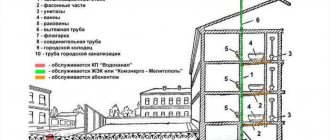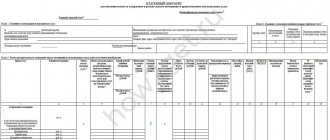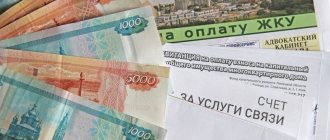Payment receipts for utility services have recently included a column designated “DHW heating.” This is a separate type of service for which residents have to pay monthly.
Failure to make payments for it leads to the formation of debt. Not all payers have an idea about and what it means in the payment document. At the same time, the legality of paying this type of utility bills is established by law.
What it is?
In the payment document, among others, there is a line - DHW.
This position assumes the cost of energy expended to provide residents with hot water according to established standards. This indicator combines the cost of hot water consumed in the system and the cost of heating it in accordance with approved standards.
Hot water in houses that have a centralized hot water supply is paid according to its consumption meter. But at the same time, the tariff for the supply of a cubic meter of water depends on the region where the supply and consumption of water occurs.
The tariff takes into account operating and administrative costs, the cost of water purification, as well as the energy spent on heating it to the regulatory level.
Economic indicators are established by the authorities of a given region and relate specifically to the consumption of hot water , which must necessarily comply with the characteristics of the standards.
If the water is actually colder than normal, then the user has the right to complain to the Criminal Code. Flow accounting can be carried out both using metering devices serving the entire house, and individually.
Who should repair water heating equipment?
To heat water, a large amount of equipment is used: boiler rooms, water heaters, pipes, distribution units, etc. All these components belong to common property. What happens if an unusual situation occurs and the equipment fails?
This is where the fun begins. The organization that directly provides the service is required to carry out repair and maintenance work. But the residents will still pay for the work. True, the heating of cold water in the receipt will remain unchanged, but the amount of maintenance of the common property will increase.
Where can I find the line?
The invoice-receipt for payment of housing and communal services (HCS) is drawn up in the form of a table. The left column lists the types of services, and their characteristics are given horizontally to the right. The second line in the table from the top is called “Hot water supply.
| Accrued | Unit change | Tariff\Size boards | Col. | Accrued | Benefit | To pay |
| Cold water supply | ||||||
| Hot water supply | M3 | 198,19 | 1,80 | 356,74 | 89,18 | 267,56 |
| Water disposal |
Often in an apartment building, residents see separately in their document how much they need to pay for the consumption (measured in cubic meters) of hot water (with characteristics that comply with the regulations) and the cost of heating their apartment. The payment for thermal energy is stated in these two lines of the receipt.
Features of self-calculation
Tariffs of management companies are not always objective. If you don’t check them and don’t appeal the receipts, the inflated bills will continue to be sent to the owners. Let's look at how to calculate the thermal energy for hot water supply.
To do this you need to know:
- tariff per cubic meter of cold water supply;
- volume of domestic hot water consumption (according to the meter on the hot water pipe);
- established and not changing standard for heating 1 m3 of water at the current tariff.
Typically, when setting the price of a heat energy component, the management company carries out its own calculations, the results of which are notified to residents at general meetings. If the management company arbitrarily increases the cost of hot water supply in the future, its actions can be appealed. The court in this case is not the only possible authority.
Component structure
In order to heat the water that enters a large city house, it is necessary to expend heat and electricity . Electricity is used by all kinds of auxiliary mechanisms - pumps, regulators, etc. The heat is used to heat a certain flow rate to the required temperature.
The sum of these two components is considered as thermal energy, for which residents must pay.
At the same time, you need to understand that not all of the invested energy reaches the end consumer; some of it is lost along the way - the water cools down in the pipes, there are leaks and similar troubles. But the consumer pays for all the energy expended.
As a result, the citizen pays all the supplier’s costs for heating water and delivering it to the apartment.
How to understand a rent receipt
Few people read their bills meticulously. Typically, residents pay attention only to their name and the amount to be paid. However, detailed knowledge on this issue will allow you to identify errors when calculating payments. Usually, when reading a document, abbreviations cause difficulties. It is not always possible to find a current account number. Other problems may arise.
To avoid all of the above, it is recommended to study a sample payment slip. What items should be on the housing and communal services receipt are established by law. The form of the document is also standard.
Explanation of the abbreviation DHW in the receipt
This is how hot water supply is indicated. However, the payment is not so much for water, but rather for heating it. This is exactly what thermal energy means on the receipt.
A house may not always be equipped with a centralized heating or hot water supply system. If a water heater is installed in the apartment, you will not have to pay for hot water. The source is important. Thermal energy for hot water supply is what comes from outside: from an autonomous boiler house near the house, from district or city networks.
Read more: Is sick leave given for toxicosis during pregnancy?
What does the amount consist of?
Commercial relations between suppliers of various types of energy and residents are formally determined by Agreements.
According to these documents, when paying, the following are taken into account and paid:
- water flow measured by a water meter on a hot pipe;
- energy spent on heating it;
- consumer benefits;
- the amount stated in the receipt was obtained as the product of the tariff for hot water and its consumption according to the meter, taking into account benefits.
If the apartment is not connected to central heating, but is equipped with an autonomous heating system, the apartment owner pays additionally for gas or electricity, depending on the type of water heater.
Complaint due to incorrect calculation of receipt
Utility billing centers distribute the amounts spent on the repair of a common house water heater among all residents of the house. However, they do not always take into account the fact that some homes are equipped with an autonomous system. As a result, the owners of such apartments are forced to pay for equipment that they do not use.
There may also be cases when residents receive receipts with increased rates. In such situations, it is recommended to contact the management organization. You can visit its settlement department or write a letter demanding an explanation of why such amounts were accrued.
If the Criminal Code does not intend to clarify the situation, then it is necessary to write a complaint. The document is transferred to the management of the management company or its secretariat. You can also submit your complaint to the Legal Department. The management of the management company is given a month to respond. If the management organization confirms the fact of incorrect calculation, then it must make a recalculation. Based on this, the consumer will be compensated for the overpayment for hot water supply.
Important! In situations where management organizations do not respond to complaints and do not take active actions, it is recommended to complain to the court. The claim is sent to the specified authority. It is important to state the essence of the violation and your requirements. In this case, it is necessary to refer to legislative acts.
The legality of charging payments for heating hot water can also be challenged in the prosecutor's office. An alternative option is to contact the authorities that control the work of the management company. Citizens can contact the Ministry of Construction, the Federal Antimonopoly Service, housing inspectorates, and Rospotrebnadzor.
Calculation of the cost of hot water supply
Electricity used to heat water is not free. Settlement centers legally charge payments for. It is important to take into account that only from the beginning of 2014 a new line appeared in receipts regarding the need to pay for hot water heating. The legality of such charges is established by Government Resolution dated May 13, 2013, number 406.
How to calculate it yourself: step-by-step instructions
To independently calculate the amount of the next payment for hot water supply, you need to use the formula:
Pi = ViP x Tcr, where:
- ViP is the water consumption for the payment period;
- Tkr is the value of the tariff for hot water supply;
- Pi — — payment for the control period.
Calculation example
The following indicators were used for the calculation:
- The amount of hot water used, measured by the water meter for February 2021, was 5 cubic meters (m3) (ViP - in the formula).
- The tariff for the region is 150 rubles. per 1 cubic meter (m3) (Tcr - in the formula).
The rent for the apartment is calculated as follows: 5 m3 x 150 rubles. = 750.00 rubles. The fee for hot water supply to an apartment is RUB 750.00.
Receipts are made to confuse us! We understand the payment for utilities from SGK
Payer information
Section: Information about the payer The section contains personal information about the owner of the premises: personal account, information about the area of the apartment and the area for the maintenance of common property, the number of registered.
The area of the home matters when calculating heating fees. In addition, it is taken into account when calculating the payment for hot or cold water, which the house spends on the maintenance of common property. You can read more about this here. After the line “Room area” there is a column “Registered”. It is important for those residents who do not have water meters installed. In such cases, payments for utilities are based on the standard established by the regional government. The standard depends on the number of people registered in the apartment.
The standard is a conditional value that is calculated based on the average human consumption of water, heat, and electricity. Established by the constituent entities of the Russian Federation.
The next line is “Area for the maintenance of common property.” This is a calculated value. How it is calculated: the area of common areas (entrances) is multiplied by the area of the apartment and divided by the area of residential and non-residential premises in the house (the formula for calculation is also prescribed in the Housing Code of the Russian Federation, Article No. 39).
This line is worth paying attention to for residents of houses that do not have a management company (MC) and the accrual for ODN (common house needs) is made by the SGK. For other residents, this information is for reference only; the management company makes payments for the maintenance of common property.
reference Information
Section: Reference information
This section provides general information about the house: the number of residents, the total area of the house, the area of residential and non-residential premises, the total area for the maintenance of common property.
Name of service provider
Section: Artist name class=”aligncenter” width=”1024″ height=”518″[/img]
This section is located in the upper right corner of the receipt. Contains information about the organization that provides utility services: heating, hot and cold water supply, sanitation (in Krasnoyarsk). The line below contains the name and details of the payment recipient - Siberian Heat Sales Company LLC (part of the SGC structure). This organization calculates and collects fees for utilities supplied by SGC enterprises.
Personal account status
Section: Personal account status
This section shows the status of the homeowner’s personal account at the time the receipt is generated separately for each service provided by SGC: heating, hot water (hot water).
In Krasnoyarsk, cold water (cold water) and water disposal (sewage) are additionally indicated.
For each type of service you can see:
- debt at the beginning of the billing month;
- monthly accrual. Where this figure comes from is explained in the receipt below in the “Calculation of the fee” section;
- paid for the month, if payment was made during the billing month;
- amount to be reimbursed (payment compensation according to the limit index)
Compensation of fees based on the maximum index is provided by the Government of the Russian Federation. The limit index is the growth rate for utility bills. If utility services rise in price faster than established by the limit index, then these expenses will be compensated by the regional budget, and the amounts to be reimbursed will appear in the “Amount to be reimbursed” column.
- to pay. This is the amount that was formed by the end of the month, taking into account cash receipts into the account until the receipt was issued;
- penalties. If you do not pay bills on time (by the 10th day of the month following the billing month), then after 31 days of delay, penalties will begin to accrue;
- total. This is the total amount payable taking into account all fees, charges, compensation and penalties. This is what you will need to pay.
Calculation of utility fees
Section: Calculation of fees for utilities class=”aligncenter” width=”1024″ height=”518″[/img]
This section provides the figures by which fees for all utilities from SGC are calculated for the month. Let's look at it in order:
- type of service. All services are identical to those indicated in the “Personal account status” section, with the exception of hot water supply (hot water supply). It is divided into two components: “DHW: coolant” with an open heating supply circuit in the house (or the “Cold water for hot” component - with a closed circuit) and “DHW: thermal energy”. Read more about the differences between closed and open heating systems in the house here.
Important! In Krasnoyarsk, the tariff for hot water consists of two elements: with an open heating supply scheme in the house - “DHW: coolant” and “DHW: thermal energy”, with a closed scheme - “Cold water for hot” and “DHW: thermal energy”.
“DHW: coolant” shows the cost of hot water that has not yet been heated at the CHP to the required temperature with an open heating system.
"Cold water for hot." This is the cost of cold water, which is heated to the required temperature directly in the house.
“DHW: thermal energy” shows how much heat costs to heat hot water to the desired temperature. It is used in closed and open heat supply systems.
These components are calculated on the basis of tariffs established by regional authorities for drinking water and thermal energy required for heating. The standard for heating is set by the Ministry of Housing and Communal Services of the region or was previously established by the local government. You can read more about the cost of hot water in Krasnoyarsk here.
- units. The units of measurement in which the volume of consumption of each utility service is calculated are shown;
- consumption standard. This information is relevant only for those who pay according to the standard. If a common house meter is installed in the house, then it is for reference only and does not participate in the calculation of fees;
- volume of utility consumption. Relevant for those residents who have meters installed. This column shows the volume of consumption of heating, hot and cold water, drainage - according to meter readings;
- rate. The tariffs set by the state (in this case, the Ministry of Tariff Policy of the Krasnoyarsk Territory) for each resource are indicated. If we multiply the volume of utility consumption, we get the amount of payment for utilities.
Reference. With installed metering devices, residents pay only for actual consumption, so they can reduce water or electricity costs if necessary. Read how to do this here.
In the absence of meters, payment occurs according to the standards established by the government of the Krasnoyarsk Territory. The amount of payment depends on the number of people registered in the apartment.
- accrued taking into account the increasing coefficient. This information is for those residents who can install meters in their apartment, but do not do so and continue to pay according to the standard. By law, an increasing factor must be applied to such owners;
- recalculations. The recalculation amount for each utility service is reflected here. Recalculation can be made in case of poor-quality service provided, in case of temporary absence, in case of a change of owner, in case of technical failures, in case of changes in the apartment: change in area, number of registered owners, etc.
- total accrued. This is the sum of all charges and recalculations for utilities for a single apartment.
All tariffs in receipts are set on the basis of regulatory documents approved by the government agency. Tariff is a conditional value that determines how much 1 cubic meter costs. m of water, 1 Gcal of heat, 1 kilowatt of electricity. It is established by a state body - the Ministry of Tariff Policy of the Krasnoyarsk Territory.
Information about recalculations
Section: Information about recalculations
Contains information about all recalculations. Recalculation for housing and communal services is a deduction of previously overpaid funds or an additional payment for the actually consumed resource - both for individual consumption and consumption of the house as a whole.
Consumption volumes according to a common house metering device (CDDU)
Section: Consumption volumes according to a common house metering device (ODPU)
This information is relevant for houses where common house meters for heating and hot water are installed. This section indicates monthly consumption volumes based on readings from public meters. Indications are submitted monthly to the SGC by management companies and homeowners associations. If residents want to get acquainted with meter readings, they must contact their management company or HOA.
Information on individual metering devices (IMU)
Section: Information on individual metering devices (IMU)
This information is intended for those who have water meters installed. Residents who have acquired meters can see the IPU number, the date of verification, the date of the last transmitted readings, the readings of the last month and the last transmitted readings.
Reverse side of the receipt
Reverse side of the receipt
On the reverse side of the receipt you can find a lot of useful information: methods for transmitting readings, ways to pay for utilities without leaving home, like SGK without leaving the couch. In the lower right corner there is useful information depending on the region.










